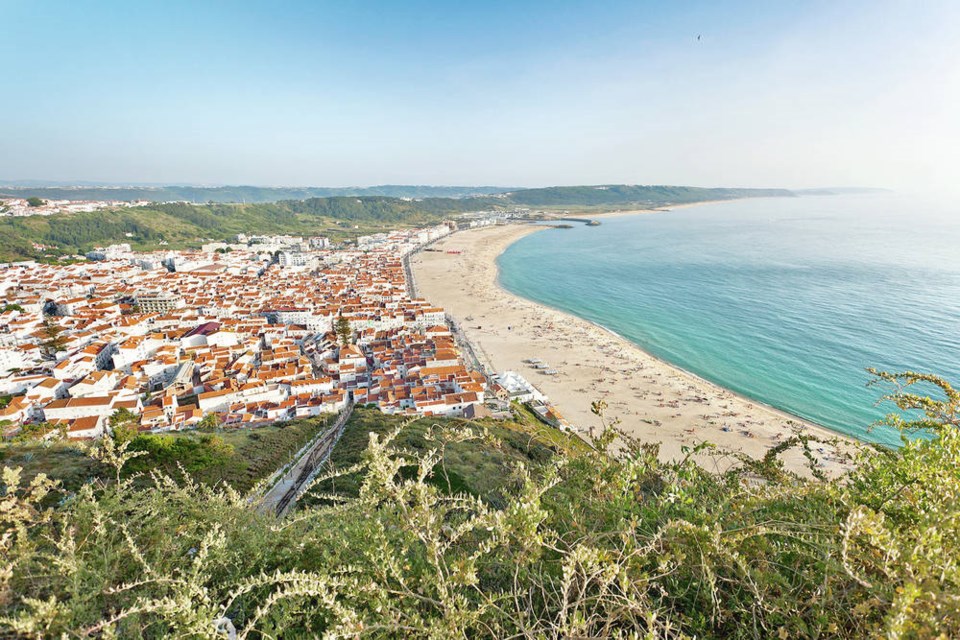As we’ve had to postpone our travels because of the pandemic, I believe a weekly dose of travel dreaming can be good medicine. Here’s a reminder of the fun that awaits us in Europe at the other end of this crisis.
Settling into a grungy fishermen’s bar in the beach town of Nazaré (two hours north of Lisbon), I order a plate of barnacles.
Yes, barnacles — called percebes here. My waiter is happy to demonstrate how to eat them: dig your thumb between the shell and the leathery skin to rip the skin off. The meat stays attached to the shell. Bite that off victoriously and wash it down with local beer.
Fresh barnacles are expensive, as they cling to rocks in the turbulent waves along the coast and are difficult and dangerous to harvest. Savouring my plate of barnacles at sundown, I gaze out at the surf attacking that stark bluff. Because I know that’s where they were gathered just hours ago, investing in a plate of barnacles feels like money well spent. I’m enjoying the endearing charms of unassuming Nazaré being itself.
Perched on a far corner of Europe, Nazaré is one of my favorite beach towns anywhere. It greets me with the energetic applause of the surf, widows with rooms to rent, and fishermen mending nets. This fishing-town-turned-tourist-retreat, set between cork groves, eucalyptus trees, and the open sea, is a place to relax in the sun. I join a world of ladies in petticoats and men who still stow cigarettes and fishhooks in their stocking caps.
Though many locals seem older than most of its buildings, the town feels like a Portuguese Coney Island — humming with young people who flock here for the beach. Off-season, it’s almost tourist free — the perfect time to take in the wild surf and get a feel for a traditional way of life.
The town’s layout is simple: a grid of skinny streets with sun-bleached apartment blocks stretching away from an expansive beach. The beach — in many places as wide as a soccer field — sweeps from the new harbour in the south to stark cliffs in the north.
It seems that most of Nazaré’s 15,000 inhabitants are in the tourist trade. But somehow traditions survive, and it’s not hard to find pockets of vivid and authentic culture. I stroll through the market and wander the back streets where people happily trade ocean views for a little shade. Laundry flaps in the wind, kids ride plastic trikes, and fish sizzle over tiny curbside hibachis.
Nazaré is famous for its traditionally clad women who — at least according to local lore — wear skirts with seven petticoats. Is that one for each day, or for the seven colors of the rainbow, or…? Make up your own legend. While the story you’ll hear may be an invention for the tourists, it contains an element of truth. In the old days, women would wait on the beach for their fishermen to sail home. To keep warm in the face of a cold sea wind, they’d wear several petticoats so they could fold layers over their heads, backs, and legs as needed. Even today, older and more traditional women wear skirts made bulky by several — but maybe not seven — petticoats. The ensemble — with boldly clashing colors — is completed with house slippers, a hand-embroidered apron, woolen cape, head scarf, and flamboyant jewelry, including chunky gold earrings (often passed down from mother to daughter).
People-watching here is like going to a living art gallery. The beach, tasty seafood, and a funicular ride are the bright lights of my lazy memories. The funicular leads from the beach up to the Sítio neighbourhood atop the cliffs. Sítio, with its own church, museum, and main square, feels like a separate village.
Back down along the beach, a local folk-music group plays and dances. This troupe — with petticoats twirling to the beat of a percussion section of bongo gourds and extra-large pine cones grating against each other — has been kicking up sand since 1934.
When these dancers were younger, the vast beach was littered with colourful fishing boats that were hauled in by oxen or teams of fishermen. But ever since a new harbour was built south of town, the working boats have been moored out of sight. Today, only a few historic vessels remain, ornamenting the sand. On the boardwalk — an artful and traditional mosaic pavement of black and white stones — squadrons of sun-dried and salted fish are stretched out on nets left under the midday sun. Locals claim they’re delicious…but I’d rather eat barnacles.
This article was adapted from Rick’s new book, For the Love of Europe.
Rick Steves (ricksteves.com) writes European guidebooks, hosts travel shows on public TV and radio, and organizes European tours. You can email Rick at [email protected] and follow his blog on Facebook.


